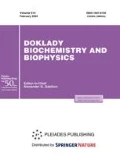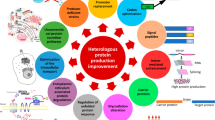Abstract
A key component of the recently described bioluminescent system of higher fungi is luciferase, a new class of proteins. The properties of fungal luciferase and their relationship with its structure are interesting both for improving autoluminescent systems already created on its basis and for creating new ones. Therefore, it is extremely important to understand the spatial structure of this protein. We have performed heterologous expression and purification of Neonothopanus nambi luciferase, obtained a protein suitable for subsequent crystallization, and also determined some biochemical properties of the recombinant luciferase.
Similar content being viewed by others
Bioluminescent systems are widely used both for research purposes and for drug development and diagnostics [1–6]. The recently clarified bioluminescent system of fungi is a promising tool for biomedical research [7]. On its basis, autonomously luminescing yeast [8] and plants [9] have already been created. However, the key component of this system, luciferase (nnLuz), remains poorly understood. The lack of homology with other enzymes does not allow modeling the spatial structure of this protein, and the difficulty of its isolation from a natural source prevents obtaining a sufficient amount of this protein for crystallization and characterization of its properties. Thus, obtaining recombinant N. nambi luciferase is currently a relevant task.
At the first stage of the study, we compared the luciferase activity of N. nambi expressed in three standard systems: E. coli, yeast Pichia pastoris, and HEK293T human cell line. The yeast P. pastoris demonstrated the maximum luminescence in response to the addition of fungal luciferin. Therefore, for further experiments, we decided to use the yeast strain, producing luciferase with a sequence of six histidine residues at the C-terminus of the protein. Yeast was cultured according to the standard procedure using the GS115 strain [10].
Yeast biomass was lysed in 100 mM Na-phosphate buffer (pH 7.0) containing 100 mM NaCl, 5 mM EDTA, 10 mM 2-mercaptoethanol, and 1 mM PMSF in a high-pressure homogenizer (600 bar, IKA HPH). The lysate was centrifuged (8000 g, 30 min) at 4°C and the membrane fraction containing luciferase was pelleted by ultracentrifugation (150 000 g, 90 min) at 4°C. To select the conditions for luciferase solubilization, the membranes were suspended in 50 mM HEPES-Na buffer (pH 8.0) containing 500 mM NaCl, 20% glycerol (buffer A), and various detergents at 4°C overnight (Fig. 1). Almost all of the detergents showed approximately the same ability to extract luciferase, except for the detergent OG (octyl glycoside). For preparative extraction, we used DDM at a concentration of 10 mM, due to its availability and good applicability for chromatography with UV detection. All chromatographic experiments were performed in the cold. The detergent-solubilized membrane fraction was loaded onto a column packed with the TALON sorbent for metal affinity chromatography equilibrated with buffer A with 0.02% DDM, and the column was washed with the same buffer. Then, the column was washed with 20 mM MES-Na, 0.5 M NaCl, and 10% glycerol buffer (pH 6.2, buffer B) containing 0.02% DDM. Adsorbed luciferase was eluted with buffer B containing 0.1% DDM and 200 mM imidazole. The fractions with the highest luminescence activity were loaded onto a column with Sephacryl S-300 in 50 mM Na-phosphate buffer (pH 7.0) containing 150 mM NaCl and 0.04% DDM for gel filtration. As a result, a recombinant N. nambi luciferase with a purity of more than 95% (Fig. 2) and a yield of 10 mg per liter of P. pastoris culture was obtained.
Solubilization of nnLuz luciferase from P. pastoris membranes suspended in buffer (see text) with addition of various detergents at a concentration of 10 mM (100 mM for OG) for 16 h at 4°C. After centrifugation (150 000 g, 90 min) at 4°C, the bioluminescence activity of luciferase in the supernatant was measured in 200 mM Na-phosphate buffer (pH 8.0) containing 500 mM Na2SO4, 0.1% DDM, and 50 μM fungal luciferin. Data are represented as the mean value ± standard deviation.
Electrophoresis under denaturing conditions of fractions during isolation of the recombinant N. nambi luciferase. Designations: 1—molecular weight markers; 2—membrane fraction of P. pastoris cells; 3—fraction containing the recombinant N. nambi luciferase after metal chelate chromatography; 4—fraction containing the recombinant N. nambi luciferase after gel filtration chromatography. The gel was stained with Coomassie Brilliant Blue G250.
During gel filtration on a Superdex 200 column in the presence of DDM detergent micelles, luciferase is eluted as a single peak corresponding to a molecular weight of about 60 kDa. On the one hand, luciferase can be a dimer, because the calculated monomer mass determined from the amino acid sequence is 31.4 kDa. However, given the size of the DDM micelle (40–70 kDa) and gel filtration conditions, luciferase is more likely to be a detergent-bound monomer, although the exact stoichiometry of this complex remains unknown.
The luciferase preparation obtained by gel filtration was studied by circular dichroism spectroscopy. The spectrum was recorded in 20 mM Na-phosphate buffer containing 100 mM NaCl and 0.04% DDM (pH 7.4) at 5°C on a J-810 spectropolarimeter (JASCO, Japan) at a protein concentration of 11 μM in a cell 0.01 cm thick. Data were processed using the CONTINLL software (CDPro package) and a set of reference spectra (SMP56). The results of the analysis of the obtained spectrum are presented in Table 1. The presence of beta-structures and alpha-helical regions presented in Table 1 indicates that the purified luciferase preparation with a high probability contains the protein with the native structure.
Luciferase activity in vitro strongly depends on the presence of detergents in the medium (Fig. 3). We compared the bioluminescence activity of the recombinant nnLuz in the presence of Tween-20, Triton X-100, NP-40, digitonin, DDM, FOS-12, and CHAPS. Different detergents contribute to the luminescence reaction to varying degrees. The highest luciferase activity was observed in the presence of FOS-12 (n-dodecylphosphocholine). However, we showed that, during storage in the presence of the detergent FOS-12, the purified nnLuz lost its activity, whereas during storage in the presence of DDM, no loss of luciferase activity was observed. Therefore, the purification and measurement of luciferase activity was also performed in the presence of DDM in order to prevent the formation of mixed micelles during measurements.
The optimum pH for the bioluminescence reaction is 8.0 (Fig. 4a). The recombinant luciferase is a temperature-sensitive enzyme: incubation at 30°C for 10 min almost completely inactivated the enzyme (Fig. 4b).
pH-dependence (a) and thermal stability (b) of N. nambi luciferase bioluminescence. The luminescence measurement was carried out after incubation for 10 min at the indicated temperature in 100 mM Na-phosphate buffer (pH 7.0). The reaction was performed in 100 mM buffer at the indicated pH containing 0.1% DDM and 50 μM fungal luciferin at room temperature. The light was integrated for 60 s. Data are represented as the mean value ± standard deviation.
The Michaelis–Menten constant was determined for the luciferin oxidation reaction catalyzed by the recombinant N. nambi luciferase. The reaction was performed at a luciferase concentration of 50 nM in 200 mM Na-phosphate buffer (pH 8.0) containing 500 mM Na2SO4 and 0.1% DDM at room temperature; the concentration of fungal luciferin was varied from 2 nM to 50 μM. The initial bioluminescence intensity values were approximated by the Michaelis–Menten function using the Origin software package. KM was 1.09 ± 0.06 μM.
Thus, in this study, we obtained and characterized the recombinant N. nambi luciferase. The developed technique for isolating this enzyme will be further used to accumulate sufficient amounts of the protein for crystallization and study of the spatial structure of luciferase by NMR.
REFERENCES
Yan, Y., Shi, P., Song, W., and Bi, S., Chemiluminescence and bioluminescence imaging for biosensing and therapy: in vitro and in vivo perspectives, Theranostics, 2019, vol. 9, pp. 4047–4065. https://doi.org/10.7150/thno.33228
Fleiss, A. and Sarkisyan, K.S., A brief review of bioluminescent systems, Curr. Genet., 2019, vol. 65, pp. 877–882. https://doi.org/10.1007/s00294-019-00951-5
Pomper, M.G. and Gelovani, J.G., Molecular Imaging in Oncology, CRC Press, 2008. https://doi.org/10.1102/1470-7330.2004.0060
Shimomura, O., Bioluminescence: Chemical Principles and Methods, Singapore: World Sci. Publ., 2006. https://doi.org/10.1142/6102
van Leeuwen, F.W., Hardwick, J.C., and van Erkel, A.R., Luminescence-based imaging approaches in the field of interventional molecular imaging, Radiology, 2015, vol. 276, no. 1, pp. 12–29. https://doi.org/10.1148/radiol.2015132698
England, C.G., Ehlerding, E.B., and Cai, W., Nanoluc: a small luciferase is brightening up the field of bioluminescence, Bioconjugate Chem., 2016, vol. 27, no. 5, pp. 1175–1187. https://doi.org/10.1021/acs.bioconjchem.6b00112
Yampol’skii, I.V., Osipova, Z.M., and Shcheglov, A.S., New bioluminescent system of fungi: prospects for use in medical research, Vestn. Ross. Gos. Med. Univ., 2018, vol. 1, pp. 80–83. https://doi.org/10.24075/vrgmu.2018.004
Kotlobay, A.A., Sarkisyan, K.S., Mokrushina, Y.A., et al., Genetically encodable bioluminescent system from fungi, Proc. Natl. Acad. Sci. U. S. A., 2018, vol. 115, pp. 12728–12732. https://doi.org/10.1073/pnas.1803615115
Mitiouchkina, T., Mishin, A.S., Somermeyer, L.G., et al., Plants with genetically encoded autoluminescence, Nat. Biotechnol., 2020. https://doi.org/10.1038/s41587-020-0500-9
Pichia Expression Kit. A Manual of Methods for Expression of Recombinant Proteins using pPICZ and PICZ-alpha in Pichia pastoris, Invitrogen ES, Catalog, 2009.
Funding
The work was supported by the Russian Science Foundation (project no. 16-14-00052-P). The creation of the luciferase-producing yeast strain nnLuz was supported by the President’s grant for state support of the leading scientific schools of the Russian Federation (NSh-2605.2020.4).
Author information
Authors and Affiliations
Corresponding author
Ethics declarations
The authors declare that they have no conflict of interest. This article does not contain any studies involving animals or human participants performed by any of the authors.
Additional information
Translated by M. Batrukova
Rights and permissions
Open Access. This article is distributed under the terms of the Creative Commons Attribution 4.0 International Public License (http://creativecommons.org/licenses/by/4.0/), which permits unrestricted use, distribution, and reproduction in any medium provided you give appropriate credit to the original author(s) and the source, provide a link to the Creative Commons license, and indicate if changes were made.
About this article
Cite this article
Gorokhovatsky, A.Y., Chepurnykh, T.V., Shcheglov, A.S. et al. The Recombinant Luciferase of the Fungus Neonothopanus nambi: Obtaining and Properties. Dokl Biochem Biophys 496, 52–55 (2021). https://doi.org/10.1134/S1607672921010051
Received:
Revised:
Accepted:
Published:
Issue Date:
DOI: https://doi.org/10.1134/S1607672921010051








